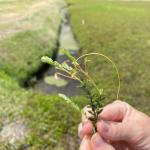Insects.
The weevil headache continues. Cranberry weevil continues to pose problems on bogs with previous histories of weevil populations. Where bogs have been treated (Fanfare, Avaunt, Actara) for weevil over a week ago, new weevil have made their way onto the bog and numbers are well over threshold (10, 20 and higher). As flower pods are being seen on many varieties now, it is important to consider retreatment to manage these high counts of weevil. Fanfare, Avaunt, Actara are the only options for weevil management (Fanfare can only be used once for export fruit). Be sure to refer to handler restrictions.
Green spanworm, on many bogs, is completing development. If you are sweeping inch long inchworms, it is too late to manage this insect. If you are still finding smaller caterpillars in high numbers (over 10 on average) a spray of Avaunt may be warranted.
A few sites have been confirmed to have black bug nymphs and blunt-nosed leafhopper nymphs. Be aware that these “new” pests can cause problems for your bog. Be aware that these insects are really, really small.
Scale spots have started to appear. Off-color round areas may be percolating scale spots. Inspect the uprights for small round black spots towards the base of the upright. Samples of uprights can be dropped off at the station or you can use the microscopes in the diagnostic lab yourself to look! If you confirm that you have a live scale infestation, you must wait until mid-June to manage this insect. They are protected under their covering until they start releasing their crawler phase.
Disease.
The preliminary keeping quality for the 2024 Massachusetts cranberry crop is VERY POOR. The final keeping quality forecast will be issued sometime after June 1. Unless things improved significantly between the initial forecast in April and the one that will be made in early in June, we do NOT recommend reducing the number and rates of fruit rot fungicide applications. Close attention should be paid to where fruit rot has been a major or regular concern.
There is a huge range of bud development stages out there! We have seen everything from beds with some buds still at cabbagehead to beds with a few open flowers. Although it is too early to spray for fruit rot (it is recommended that applications begin between 10-50% bloom), it is not too early to start thinking about your fungicide program and formulate a plan!
Fungicides with the same FRAC (Fungicide Resistance Action Committee) codes have similar modes of action and should not be used repeatedly. When planning for upcoming fruit rot applications, it is important to alternate or mix fungicides with different modes of action for resistance management. Do not apply more than two applications of Group 3 and Group 11 fungicides (e.g., Proline, QuadrisTop, Indar and Abound) due to high resistance concerns.
If you are considering using broad-spectrum fungicides such as chlorothalonil (e.g., Bravo Weather Stik) and/or mancozeb (e.g., Manzate Max) as part of your fungicide regime, it is recommended to use them early in the “possible infection period” when the maximum number of flowers are open (early to mid-bloom).
Higher temps can facilitate the spread of phytophthora. If you suspect you have this disease, you can bring in samples from your problem areas for diagnosis by our plant pathology lab before treating with fungicides. Make sure your vine sample includes roots! And remember that correcting drainage issues is a key part of managing this disease.
Weeds.
If you have applied Kerb, or plan to apply Kerb (which is only permitted for dodder control via the Section 18 label that is expiring June 30) you must report your use to the state.
The Kerb Applicator Reporting Form 2024 is now available on our website https://ag.umass.edu/cranberry/services/special-pesticide-labels
Dodder is up! We even found some dodder attached to cranberry, dewberry, and loosestrife on the edge of a bed. Dodder can be found in higher numbers in your loading area.
Various grass species are at different growth stages. Some have already flowered, while others are still not actively growing. The grass herbicides (Poast, Select Max, Intensity One, etc.) are most effective on actively growing grasses BEFORE they flower. These herbicides injure grasses by interfering with an enzyme that grass plants need to make cell membranes. They work best when in the process of adding new cells and increasing in size. So, while some grasses may remain green through the winter (like the center of a poverty grass tussock), which shows the grass is living, it is not in a state of active growth. Simply being green/alive is not a good indicator for when to use these herbicides. If you missed the window and the grass has already flowered, you might get some control but not maximum efficacy. Remember, application of clethodim products (Select Max, Intensity One) during roughneck can cause abnormal flowers!
Intensity One is the ONLY grass herbicide that can be chemigated. Be sure to get a copy of the SLN (or 24c) label to make a legal application. The SLN also allows applications throughout hook and fruit set, but again, this is only for Intensity One.
Other notes.
The Cranberry Station is hosting a Coffee Chat on Wednesday, June 12, 2024, between 9:00-11:00 AM. Do you want to chat about what’s happening on your bog? Have a question about a weed or a something you can’t identify? Stop by the Station, grab a cup of coffee, a snack and talk with scientists and fellow growers. Bring a sample from your bog and take a look under the microscope. We are looking forward to seeing you!
The Cranberry Institute publishes regional cranberry pesticide charts every year. You can contact Anne Cote acote@cranberryinstitute.org for a copy of the 2024 printed chart and get on the mailing list for next year or download the chart from the CI Website and print it out yourself from the “Members Only” page https://www.cranberryinstitute.org/ (ask Anne for the password if you need it).
